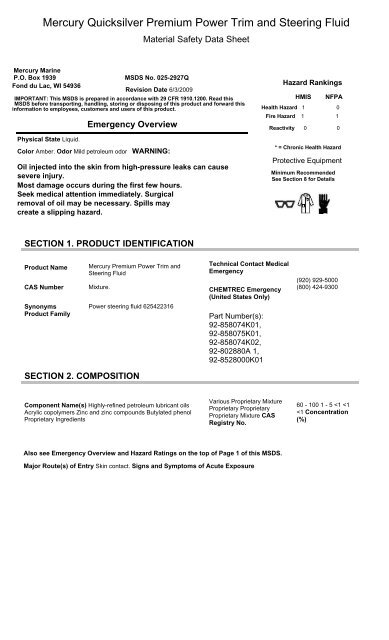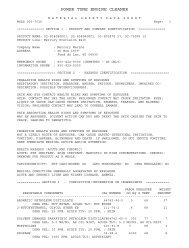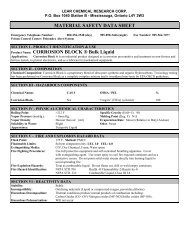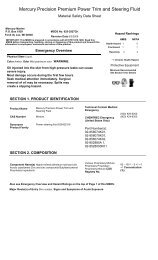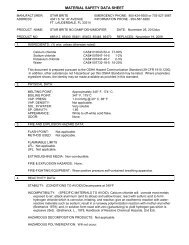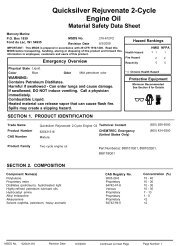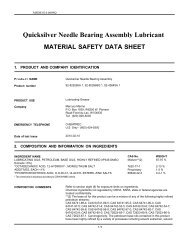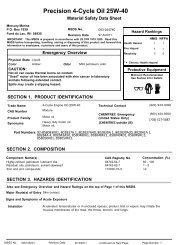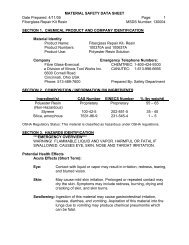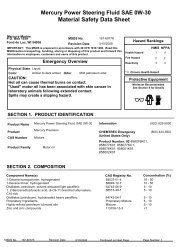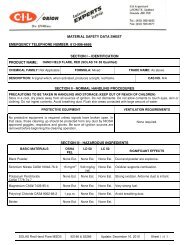Mercury Quicksilver Premium Power Trim and ... - Mercury Marine
Mercury Quicksilver Premium Power Trim and ... - Mercury Marine
Mercury Quicksilver Premium Power Trim and ... - Mercury Marine
Create successful ePaper yourself
Turn your PDF publications into a flip-book with our unique Google optimized e-Paper software.
<strong>Mercury</strong> <strong>Quicksilver</strong> <strong>Premium</strong> <strong>Power</strong> <strong>Trim</strong> <strong>and</strong> Steering Fluid<br />
Material Safety Data Sheet<br />
<strong>Mercury</strong> <strong>Marine</strong><br />
P.O. Box 1939 MSDS No. 025-2927Q<br />
Fond du Lac, WI 54936<br />
Revision Date 6/3/2009<br />
Hazard Rankings<br />
IMPORTANT: This MSDS is prepared in accordance with 29 CFR 1910.1200. Read this HMIS NFPA<br />
MSDS before transporting, h<strong>and</strong>ling, storing or disposing of this product <strong>and</strong> forward this<br />
information to employees, customers <strong>and</strong> users of this product.<br />
Health Hazard 1 0<br />
Fire Hazard 1 1<br />
Emergency Overview<br />
Reactivity 0 0<br />
Physical State Liquid.<br />
Color Amber. Odor Mild petroleum odor WARNING:<br />
Oil injected into the skin from high-pressure leaks can cause<br />
severe injury.<br />
Most damage occurs during the first few hours.<br />
Seek medical attention immediately. Surgical<br />
removal of oil may be necessary. Spills may<br />
create a slipping hazard.<br />
* = Chronic Health Hazard<br />
Protective Equipment<br />
Minimum Recommended<br />
See Section 8 for Details<br />
SECTION 1. PRODUCT IDENTIFICATION<br />
Product Name<br />
CAS Number<br />
Synonyms<br />
Product Family<br />
<strong>Mercury</strong> <strong>Premium</strong> <strong>Power</strong> <strong>Trim</strong> <strong>and</strong><br />
Steering Fluid<br />
Mixture.<br />
<strong>Power</strong> steering fluid 625422316<br />
Technical Contact Medical<br />
Emergency<br />
CHEMTREC Emergency<br />
(United States Only)<br />
Part Number(s):<br />
92-858074K01,<br />
92-858075K01,<br />
92-858074K02,<br />
92-802880A 1,<br />
92-8528000K01<br />
(920) 929-5000<br />
(800) 424-9300<br />
SECTION 2. COMPOSITION<br />
Component Name(s) Highly-refined petroleum lubricant oils<br />
Acrylic copolymers Zinc <strong>and</strong> zinc compounds Butylated phenol<br />
Proprietary Ingredients<br />
Various Proprietary Mixture<br />
Proprietary Proprietary<br />
Proprietary Mixture CAS<br />
Registry No.<br />
60 - 100 1 - 5
Inhalation<br />
Eye Contact<br />
Skin Contact<br />
Ingestion<br />
Chronic Health Effects<br />
Summary<br />
Conditions Aggravated<br />
by Exposure Target<br />
Organs<br />
Carcinogenic Potential<br />
At elevated temperatures or in enclosed spaces, product mist or vapors may irritate the<br />
mucous membranes of the nose, the throat, bronchi, <strong>and</strong> lungs.<br />
This product can cause transient mild eye irritation with short-term contact with liquid sprays or<br />
mists. Symptoms include stinging, watering, redness, <strong>and</strong> swelling.<br />
This material can cause mild skin irritation from prolonged or repeated skin contact. Injection<br />
under the skin can cause inflammation <strong>and</strong> swelling. Injection of pressurized hydrocarbons can<br />
cause severe, permanent tissue damage. Initial symptoms may be minor. Injection of petroleum<br />
hydrocarbons requires immediate medical attention.<br />
If swallowed, large volumes of material can cause generalized depression, headache,<br />
drowsiness, nausea, vomiting <strong>and</strong> diarrhea. Smaller doses can cause a laxative effect. If<br />
aspirated into the lungs, liquid can cause lung damage.<br />
This product contains a petroleum-based mineral oil. Prolonged or repeated skin contact can<br />
cause mild irritation <strong>and</strong> inflammation characterized by drying, cracking, (dermatitis) or oil acne.<br />
Repeated or prolonged inhalation of petroleum-based mineral oil mists at concentrations above<br />
applicable workplace exposure levels can cause respiratory irritation or other pulmonary effects.<br />
Disorders of the following organs or organ systems that may be aggravated by significant<br />
exposure to this material or its components include: Skin<br />
May cause damage to the following organs: skin.<br />
This product is not known to contain any components at concentrations above 0.1% which are<br />
considered carcinogenic by OSHA, IARC or NTP.<br />
SECTION 4. FIRST AID MEASURES<br />
Take proper precautions to ensure your own health <strong>and</strong> safety before attempting rescue or providing first aid.<br />
For more specific information, refer to Exposure Controls <strong>and</strong> Personal Protection in Section 8 of this MSDS.<br />
Inhalation<br />
Move victim to fresh air. If victim is not breathing, immediately begin rescue breathing. If<br />
breathing is difficult, 100 percent humidified oxygen should be administered by a qualified<br />
individual. Seek medical attention immediately. Keep the affected individual warm <strong>and</strong> at rest.<br />
Check for <strong>and</strong> remove contact lenses. Flush eyes with cool, clean, low-pressure water while<br />
occasionally lifting <strong>and</strong> lowering eyelids. Seek medical attention if excessive tearing, redness, or<br />
Eye Contact<br />
pain persists.<br />
If burned by hot material, cool skin by quenching with large amounts of cool water. For contact<br />
with product at ambient temperatures, remove contaminated shoes <strong>and</strong> clothing. Wipe off excess<br />
Skin Contact<br />
material. Wash exposed skin with mild soap <strong>and</strong> water. Seek medical attention if tissue appears<br />
damaged or if pain or irritation persists. Thoroughly clean contaminated clothing before reuse.<br />
Clean or discard contaminated leather goods. If material is injected under the skin, seek medical<br />
attention immediately.<br />
Ingestion Do not induce vomiting unless directed to by a physician. Do not give anything to drink unless directed to by a<br />
physician. Never give anything by mouth to a person who is not fully conscious. Seek medical attention immediately.
Notes to Physician SKIN: In the event of injection in underlying tissue, immediate treatment should include<br />
extensive incision, debridement <strong>and</strong> saline irrigation. Inadequate treatment can result in ischemia <strong>and</strong> gangrene. Early<br />
symptoms may be minimal.<br />
INGESTION: The viscosity range of the product(s) represented by this MSDS is greater than 100<br />
SUS at 100°F. Careful gastric lavage may be considered to evacuate large quantities of material.<br />
SECTION 5. FIRE FIGHTING MEASURES<br />
NFPA Flammability<br />
Classification<br />
Flash Point<br />
NFPA Class-IIIB combustible material.<br />
Closed cup: 171°C (340°F). (Pensky-Martens.) Open cup: 200°C (392°F) (Clevel<strong>and</strong>.).<br />
Lower Flammable Limit<br />
Autoignition<br />
Temperature Hazardous<br />
Combustion<br />
Products Special<br />
Properties<br />
Extinguishing Media<br />
Protection of Fire<br />
Fighters<br />
No data.<br />
Not available.<br />
Upper Flammable Limit No data.<br />
Carbon dioxide, carbon monoxide, smoke, fumes, unburned hydrocarbons <strong>and</strong> oxides of<br />
sulfur, phosphorus, zinc <strong>and</strong>/or nitrogen.<br />
This material can burn but will not readily ignite. This material will release vapors when heated<br />
above the flash point temperature that can ignite when exposed to a source of ignition. In<br />
enclosed spaces, heated vapor can ignite with explosive force. Mists or sprays may burn at<br />
temperatures below the flash point.<br />
Use dry chemical, foam, carbon dioxide or water fog. Water or foam may cause frothing.<br />
Carbon dioxide <strong>and</strong> inert gas can displace oxygen. Use caution when applying carbon<br />
dioxide or inert gas in confined spaces.<br />
Firefighters must use full bunker gear including NIOSH-approved positive pressure selfcontained<br />
breathing apparatus to protect against potential hazardous combustion or<br />
decomposition products <strong>and</strong> oxygen deficiencies.<br />
SECTION 6. ACCIDENTAL RELEASE MEASURES<br />
Take proper precautions to ensure your own health <strong>and</strong> safety before attempting spill control or clean-up. For<br />
more specific information, refer to the Emergency Overview on Page 1, Exposure Controls <strong>and</strong> Personal<br />
Protection in Section 8 <strong>and</strong> Disposal Considerations in Section 13 of this MSDS.<br />
Do not touch damaged containers or spilled material unless wearing appropriate protective<br />
equipment. Slipping hazard; do not walk through spilled material. Stop leak if you can do so<br />
without risk. For small spills, absorb or cover with dry earth, s<strong>and</strong>, or other inert non-combustible<br />
absorbent material <strong>and</strong> place into waste containers for later disposal. Contain large spills to<br />
maximize product recovery or disposal. Prevent entry into waterways or sewers. In urban area,<br />
cleanup spill as soon as possible. In natural environments, seek cleanup advice from specialists to<br />
minimize physical habitat damage. This material will float on water. Absorbent pads <strong>and</strong> similar<br />
materials can be used. Comply with all laws <strong>and</strong> regulations.<br />
SECTION 7. HANDLING AND STORAGE<br />
H<strong>and</strong>ling Keep containers closed <strong>and</strong> do not h<strong>and</strong>le or store near heat, sparks, or any other potential ignition sources.<br />
Avoid contact with oxidizing agents. Never siphon by mouth. Avoid contact with eyes, skin, <strong>and</strong> clothing. Avoid contamination<br />
<strong>and</strong> extreme temperatures.<br />
Empty containers may contain product residues that can ignite with explosive force. Drain <strong>and</strong><br />
purge equipment, as necessary, to remove material residues. Follow proper entry procedures,<br />
including compliance with 29 CFR 1910.146 prior to entering confined spaces such as tanks or<br />
pits. Use appropriate respiratory protection when concentrations exceed any
established occupational exposure level (See Section 8). Promptly remove contaminated<br />
clothing. Wash exposed skin thoroughly with soap <strong>and</strong> water after h<strong>and</strong>ling.<br />
Do not pressurize, cut, weld, braze solder, drill, grind or expose containers to flames, sparks, heat<br />
or other potential ignition sources. Protect containers against physical damage. Consult<br />
appropriate federal, state <strong>and</strong> local authorities before reusing, reconditioning, reclaiming,<br />
recycling or disposing of empty containers <strong>and</strong>/or waste residues of this product.<br />
Storage Keep container tightly closed. Store in a cool, dry, well-ventilated area. Store only in approved containers. Do<br />
not store with strong oxidizing agents. Do not store at elevated temperatures. Avoid storing product in direct sunlight for<br />
extended periods of time. Storage area must meet OSHA requirements <strong>and</strong> applicable fire codes. Consult appropriate federal,<br />
state <strong>and</strong> local authorities before reusing, reconditioning, reclaiming, recycling or disposing of empty containers or waste<br />
residues of this product.<br />
SECTION 8. EXPOSURE CONTROLS AND PERSONAL PROTECTION<br />
Engineering Controls<br />
Personal Protective<br />
Equipment<br />
Provide exhaust ventilation or other engineering controls to keep the airborne concentrations of<br />
mists <strong>and</strong>/or vapors below the recommended exposure limits (see below). An eye wash station<br />
<strong>and</strong> safety shower should be located near the work-station.<br />
Personal protective equipment should be selected based upon the conditions under which this<br />
material is used. A hazard assessment of the work area for PPE requirements should be<br />
conducted by a qualified professional pursuant to OSHA regulations. The following pictograms<br />
represent the minimum requirements for personal protective equipment. For certain<br />
operations, additional PPE may be required.<br />
Eye Protection<br />
H<strong>and</strong> Protection<br />
Body Protection<br />
Respiratory Protection<br />
General Comments<br />
Safety glasses equipped with side shields are recommended as minimum protection in<br />
industrial settings. Wear goggles if splashing or spraying is anticipated. Wear goggles <strong>and</strong> face<br />
shield if material is heated above 125°F (51°C). Have suitable eye wash water available.<br />
None required for incidental contact. Use gloves constructed of chemical resistant materials<br />
such as heavy nitrile rubber if frequent or prolonged contact is expected. Use heat-protective<br />
gloves when h<strong>and</strong>ling product at elevated temperatures.<br />
Use clean protective clothing if splashing or spraying conditions are present. Protective<br />
clothing may include long-sleeve outer garment, apron, or lab coat. If significant contact<br />
occurs, remove oil-contaminated clothing as soon as possible <strong>and</strong> promptly shower.<br />
Launder contaminated clothing before reuse or discard. Wear heat protective boots <strong>and</strong><br />
protective clothing when h<strong>and</strong>ling material at elevated temperatures.<br />
The need for respiratory protection is not anticipated under normal use conditions <strong>and</strong> with<br />
adequate ventilation. If elevated airborne concentrations above applicable workplace exposure<br />
levels are anticipated, a NIOSH-approved organic vapor respirator equipped with a dust/mist<br />
prefilter should be used. Protection factors vary depending upon the type of respirator used.<br />
Respirators should be used in accordance with OSHA requirements (29 CFR 1910.134).<br />
Use good personal hygiene practices. Wash h<strong>and</strong>s <strong>and</strong> other exposed skin areas with plenty of<br />
mild soap <strong>and</strong> water before eating, drinking, smoking, use of toilet facilities, or leaving work. DO<br />
NOT use gasoline, kerosene, solvents or harsh abrasives as skin cleaners. Since specific<br />
exposure st<strong>and</strong>ards/control limits have not been established for this product, the "Oil Mist,<br />
Mineral" exposure limits shown below are suggested as minimum control guidelines.<br />
Occupational Exposure Guidelines Substance Applicable Workplace Exposure Levels
Oil Mist, Mineral ACGIH (United States).TWA: 5 mg/m 3 STEL: 10 mg/m 3<br />
OSHA (United States).<br />
TWA: 5 mg/m 3<br />
SECTION 9. PHYSICAL AND CHEMICAL PROPERTIES (TYPICAL)<br />
Physical State Liquid. Color Amber. Odor Mild petroleum odor<br />
Specific<br />
Gravity<br />
0.87 (Water = 1) pH Not applicable Vapor<br />
Density<br />
>1 (Air = 1)<br />
Boiling Range<br />
Not available.<br />
Melting/Freezing Point<br />
Not available.<br />
Vapor<br />
Pressure<br />
Solubility in<br />
Water<br />
2000 mg/kg [Rabbit].<br />
Mineral oil mists derived from highly refined oils are reported to have low acute <strong>and</strong> sub-acute<br />
toxicities in animals. Effects from single <strong>and</strong> short-term repeated exposures to high concentrations<br />
of mineral oil mists well above applicable workplace exposure levels include lung inflammatory<br />
reaction, lipoid granuloma formation <strong>and</strong> lipoid pneumonia. In acute <strong>and</strong> sub-acute studies<br />
involving exposures to lower concentrations of mineral oil mists at or near current work place<br />
exposure levels produced no significant toxicological effects. In long term studies (up to two<br />
years) no carcinogenic effects have been reported in any animal species tested.<br />
Hydraulic oil: Repeated or prolonged skin contact with certain hydraulic oils can cause mild<br />
skin irritation characterized by drying, cracking (dermatitis) or oil acne. Injection under the skin,<br />
in muscle or into the blood stream can cause irritation, inflammation, swelling, fever, <strong>and</strong><br />
systemic
effects, including mild central nervous system depression. Injection of pressurized<br />
hydrocarbons can cause severe, permanent tissue damage.<br />
SECTION 12. ECOLOGICAL INFORMATION<br />
Ecotoxicity<br />
Environmental Fate<br />
Analysis for ecological effects has not been conducted on this product. However, if spilled, this<br />
product <strong>and</strong> any contaminated soil or water may be harmful to human, animal, <strong>and</strong> aquatic life.<br />
Also, the coating action associated with petroleum <strong>and</strong> petroleum products can be harmful or<br />
fatal to aquatic life <strong>and</strong> waterfowl.<br />
Biodegradability: Inherently biodegradable in aerobic conditions.<br />
Partition Coefficient (log Kow): >6 (based on similar materials)<br />
Photodegradation: Based on similar materials, this product will have little or no tendency to<br />
partition to air. Hydrocarbons from this product which do partition to air are expected to rapidly<br />
photodegrade.<br />
Stability in Water: Not readily susceptible to hydrolysis under aquatic conditions.<br />
Distribution: Principally to soil <strong>and</strong> sediment. Petroleum-based (mineral) lubricating oils normally<br />
will float on water. In stagnant or slow-flowing waterways, an oil layer can cover a large surface<br />
area. As a result, this oil layer might limit or eliminate natural atmospheric oxygen transport into<br />
the water. With time, if not removed, oxygen depletion in the waterway may be sufficient to<br />
cause a fish kill or create an anaerobic environment.<br />
SECTION 13. DISPOSAL CONSIDERATIONS<br />
Hazard characteristic <strong>and</strong> regulatory waste stream classification can change with product use. Accordingly, it is the<br />
responsibility of the user to determine the proper storage, transportation, treatment <strong>and</strong>/or disposal methodologies<br />
for spent materials <strong>and</strong> residues at the time of disposition.<br />
Conditions of use may cause this material to become a "hazardous waste", as defined by federal<br />
or state regulations. It is the responsibility of the user to determine if the material is a "hazardous<br />
waste" at the time of disposal. Transportation, treatment, storage, <strong>and</strong> disposal of waste material<br />
must be conducted in accordance with RCRA regulations (see 40 CFR 260 through 40 CFR<br />
271). State <strong>and</strong>/or local regulations may be more restrictive. Contact your regional US EPA office<br />
for guidance concerning case specific disposal issues. Empty drums <strong>and</strong> pails retain residue. DO<br />
NOT pressurize, cut, weld, braze, solder, drill, grind, or expose this product's empty container to<br />
heat, flame, or other ignition sources. DO NOT attempt to clean it. Empty drums <strong>and</strong> pails should<br />
be drained completely, properly bunged or sealed, <strong>and</strong> promptly sent to a reconditioner.<br />
SECTION 14. TRANSPORT INFORMATION<br />
The shipping description below may not represent requirements for all modes of transportation, shipping<br />
methods or locations outside of the United States. US DOT Status Not regulated by the U.S. Department of<br />
Transportation as a hazardous material. Proper Shipping Name Not regulated. Hazard Class Not regulated. Packing<br />
Group Not applicable. UN/NA Number Not regulated.<br />
Reportable Quantity A Reportable Quantity (RQ) has not been established for this material.<br />
Placard(s)
SECTION 15. REGULATORY INFORMATION<br />
MARPOL III Status Not a DOT "<strong>Marine</strong><br />
Pollutant" per 49 CFR<br />
171.8.<br />
Emergency Response Oil: The Not product(s) applicable. represented Guide No. by this MSDS is (are)<br />
regulated as “oil” under 49 CFR Part 130. Shipments by rail<br />
or highway in packaging having a capacity of 3500 gallons<br />
or more or in a quantity greater 42,000 gallons are subject<br />
to these requirements. In addition, mixtures containing 10%<br />
or more of this product may be subject to these<br />
requirements.<br />
TSCA Inventory<br />
SARA 302/304<br />
Emergency Planning<br />
<strong>and</strong> Notification<br />
SARA 311/312 Hazard<br />
Identification<br />
SARA 313 Toxic<br />
Chemical Notification<br />
<strong>and</strong> Release Reporting<br />
CERCLA<br />
This product <strong>and</strong>/or its components are listed on the Toxic Substances Control Act (TSCA)<br />
inventory.<br />
The Superfund Amendments <strong>and</strong> Reauthorization Act of 1986 (SARA) Title III requires<br />
facilities subject to Subparts 302 <strong>and</strong> 304 to submit emergency planning <strong>and</strong> notification<br />
information based on Threshold Planning Quantities (TPQs) <strong>and</strong> Reportable Quantities (RQs)<br />
for "Extremely Hazardous Substances" listed in 40 CFR 302.4 <strong>and</strong> 40 CFR 355. No<br />
components were identified.<br />
The Superfund Amendments <strong>and</strong> Reauthorization Act of 1986 (SARA) Title III requires facilities<br />
subject to this subpart to submit aggregate information on chemicals by "Hazard Category" as<br />
defined in 40 CFR 370.2. This material would be classified under the following hazard<br />
categories:<br />
No SARA 311/312 hazard categories identified.<br />
This product contains the following components in concentrations above de minimis levels that<br />
are listed as toxic chemicals in 40 CFR Part 372 pursuant to the requirements of Section 313 of<br />
SARA: No components were identified.<br />
The Comprehensive Environmental Response, Compensation, <strong>and</strong> Liability Act of 1980<br />
(CERCLA) requires notification of the National Response Center concerning release of quantities<br />
of "hazardous substances" equal to or greater than the reportable quantities (RQ's) listed in 40<br />
CFR 302.4. As defined by CERCLA, the term "hazardous substance" does not include petroleum,<br />
including crude oil or any fraction thereof which is not otherwise specifically designated in 40 CFR<br />
302.4. Chemical substances present in this product or refinery stream that may be subject to this<br />
statute are: Zinc <strong>and</strong> Zinc Compounds, Concentration:


